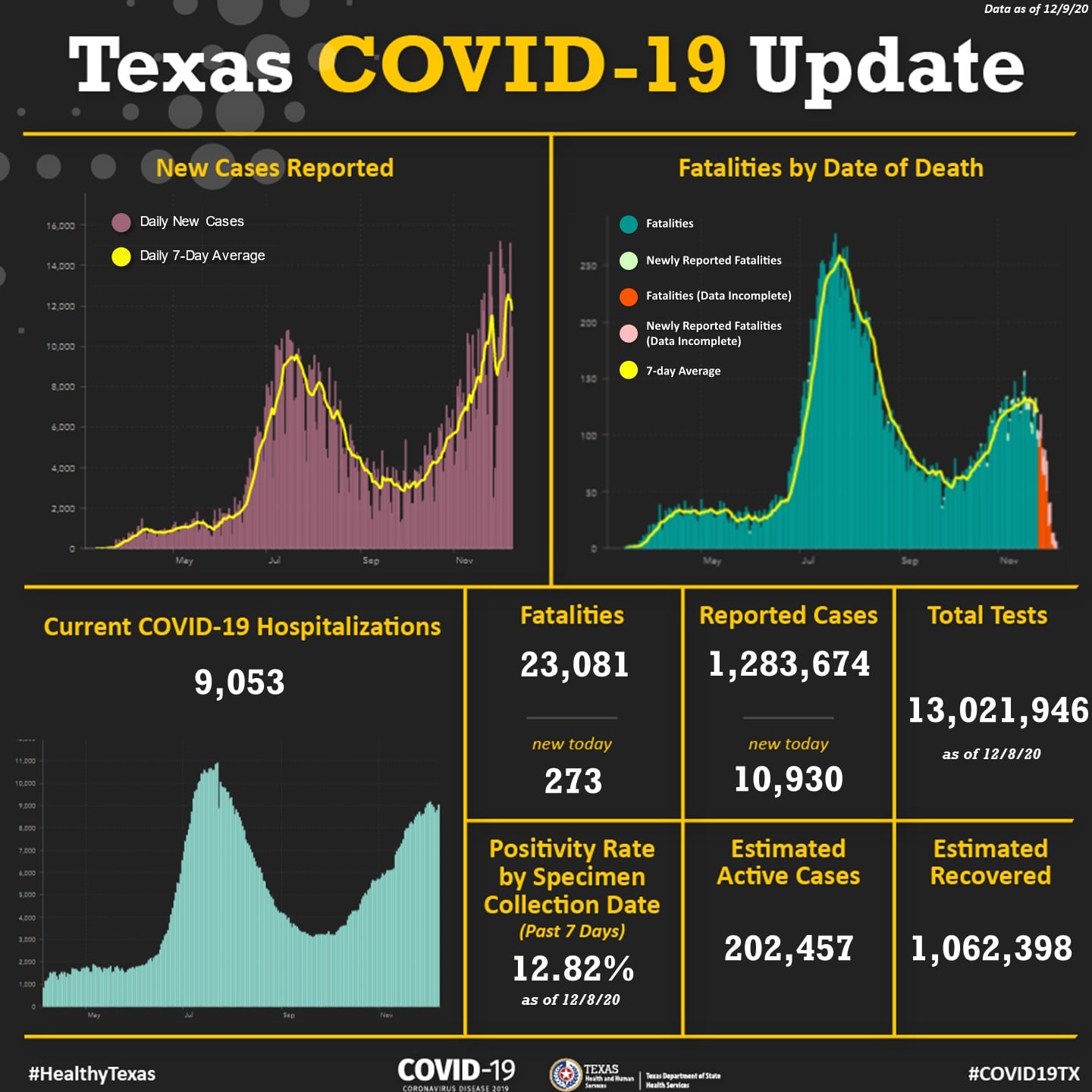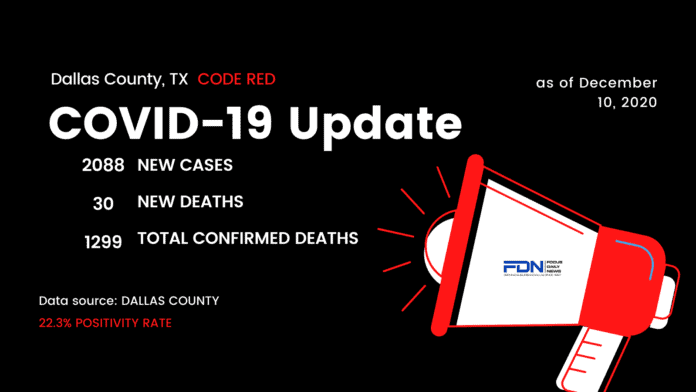Dallas County Deaths Increase, 2,088 New COVID Cases
DALLAS — As of 12:00 pm December 10, 2020, Dallas County Health and Human Services is reporting 2,088 additional positive cases of 2019 novel coronavirus (COVID-19) in Dallas County, 1,717 confirmed cases and 371 probable cases. There is a cumulative total of 139,950 cases (PCR test), including 1,299 deaths. There is a cumulative total of 14,426 probable cases (antigen test), including 48 probable deaths.
The additional deaths being reported today include the following:
- A man in his 50’s who was a resident of the City of Irving. He had been critically ill in an area hospital, and had underlying high risk health conditions.
- A man in his 50’s who was a resident of the City of Dallas. He had been critically ill in an area hospital, and had underlying high risk health conditions.
- A woman in her 50’s who was a resident of the City of Seagoville. She had been critically ill in an area hospital, and had underlying high risk health conditions.
- A woman in her 50’s who was a resident of the City of Desoto. She had been critically ill in an area hospital, and had underlying high risk health conditions.
- A man in his 60’s who was a resident of the City of Dallas. He had been critically ill in an area hospital, and had underlying high risk health conditions.
- A woman in her 60’s who was a resident of the City of Mesquite. She had been critically ill in an area hospital, and had underlying high risk health conditions.
- A woman in her 60’s who was a resident of the City of Garland. She had been critically ill in an area hospital, and had underlying high risk health conditions.
- A woman in her 60’s who was a resident of the City of Dallas. She had been critically ill in an area hospital, and had underlying high risk health conditions.
- A woman in her 60’s who was a resident of the City of Dallas. She had been critically ill in an area hospital, and had underlying high risk health conditions.
- A man in his 60’s who was a resident of the City of Dallas. He expired in an area hospital ED, and had underlying high risk health conditions.
- A woman in her 60’s who was a resident of the City of Dallas. She had been critically ill in an area hospital, and had underlying high risk health conditions.
- A man in his 60’s who was a resident of the City of Dallas. She had been critically ill in an area hospital, and had underlying high risk health conditions.
- A man in his 60’s who was a resident of the City of Dallas. He had been critically ill in an area hospital, and had underlying high risk health conditions
- A woman in her 60’s who was a resident of a long term care facility in Dallas. She had been hospitalized, and had underlying high risk health conditions.
- A man in his 70’s who was a resident of the City of Dallas. He had been hospitalized, and had underlying high risk health conditions.
- A woman in her 70’s who was a resident of the City of Dallas. She had been hospitalized, and had underlying high risk health conditions.
- A man in his 70’s who was a resident of the City of Dallas. He had been critically ill in an area hospital, and had underlying high risk health conditions.
- A woman in her 70’s who was a resident of the City of Dallas. She had been critically ill in an area hospital, and had underlying high risk health conditions.
- A woman in her 70’s who was a resident of the City of Duncanville. She had been critically ill in an area hospital, and had underlying high risk health conditions.
- A man in his 70’s who was a resident of the City of Dallas. He had been critically ill in an area hospital, and did not have underlying high risk health conditions.
- A man in his 70’s who was a resident of the City of Dallas. He had been hospitalized, and had underlying high risk health conditions.
- A man in his 70’s who was a resident of the City of Dallas. He had been critically ill in an area hospital, and did not have underlying high risk health conditions.
- A man in his 70’s who was a resident of the City of Dallas. He had been critically ill in an area hospital, and did not have underlying high risk health conditions.
- A man in his 80’s who was a resident of the City of Dallas. He had been critically ill in an area hospital, and did not have underlying high risk health conditions.
- A woman in her 80’s who was a resident of the City of Dallas. She had been critically ill in an area hospital, and had underlying high risk health conditions.
- A man in his 80’s who was a resident of the City of Garland. He had been hospitalized, and had underlying high risk health conditions.
- A woman in her 80’s who was a resident of long term care facility in the City of Dallas. She expired in the facility, and had underlying high risk health conditions.
- A man in his 80’s who was a resident of the City of Dallas. He had been critically ill in an area hospital, and did not have underlying high risk health conditions.
- A man in his 90’s who was a resident of the City of Desoto. He had been hospitalized, and had underlying high risk health conditions.
- A man in his 90’s who was a resident of the City of Dallas. He had been critically ill in an area hospital, and had underlying high risk health conditions.

Over the past 30 days, there have been 4,520 COVID-19 cases in school-aged children and staff reported from 735 separate K-12 schools in Dallas County, including 681 staff members. Of these cases, 534 have been associated with extracurricular activities, including athletics.
There were 800 COVID-19 patients in acute care in Dallas County for the period ending on Wednesday, December 9. The number of emergency room visits for COVID-19 like symptoms in Dallas County was 552 for the same time-period, which represents around 22 percent of all emergency department visits in the county according to information reported to the North Central Texas Trauma Regional Advisory Council. Additionally, hospitals have many patients who remain hospitalized with complications following COVID-19, but are no longer in need of isolation and therefore not reflected in these numbers.
Hospitalizations Remain Elevated In TSA E
On December 3, Trauma Service Area E (TSA E), which includes Dallas County and the greater Dallas-Fort Worth Metroplex, reached seven consecutive days where the percentage of COVID-19 confirmed patients in regional hospitals, as a percentage of available hospital beds, exceeded 15 percent. According to Governor Abbott’s Executive Order GA-32 (GA-32), this makes TSA E an area with high hospitalizations and certain occupancy reductions are automatically triggered by reaching this threshold.
“Today we announce 2,088 new COVID positive cases and 30 additional deaths. These numbers are yet again a grim reminder of the need for shared sacrifice and patriotism from everyone as we work to keep our community and our country strong until the vaccine is widely administered and we can achieve the ‘herd immunity’ that will only be available when the vast majority of Americans have been vaccinated.
Think of your mask and your smart decisions to avoid crowds and forgo get-togethers as the vaccine that is available to all of us now. Think of our healthcare providers’ pleas for you to avoid crowds and forgo get-togethers, not as an abridgement to your individual liberty, since ultimately it is up to you to decide whether you will listen to their pleas, but rather as an opportunity for small sacrifices and patriotism that protects not only you and your family but people that you don’t even know.
We know that with each outbreak, the disease will spread to more and more people. Although our tracing in Texas is not robust enough to ascertain who gets an infection three or four separations after an outbreak in a family or business, in countries and in places where that is possible, we know that almost all infections eventually spread to a person who is ill-equipped to handle the virus and pays a high price.
Please everyone, do your part and stay in the fight by practicing good self-care. The six tenants of self-care are: getting adequate sleep, eating right, exercise, spending time with the people that you love, and two that you may not think of intuitively, finding something that makes you laugh every day and engaging in intentional thankfulness. When we are thankful, we tend to crowd out negative feelings and we do have so much to be thankful for, even in the face of this pandemic. I’m thankful for you and the smart decisions I know you will make as we work together to protect our community and our country at this time of high spread,” said Dallas County Judge Clay Jenkins.
All Dallas County COVID-19 Updates and Information can be found here: https://www.dallascounty.org/covid-19/ and all guidance documents can be found here: https://www.dallascounty.org/covid-19/guidance-health.php
Specific Guidance for the Public:
· Dallas County COVID-19 Related Health Guidance for the Public
· Dallas County Guidance for Individuals at High-Risk for Severe COVID-19














